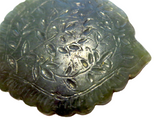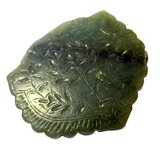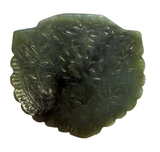When thinking about Jade, one usually thinks about China. Jade is found all over the world, usually though in small quantities, and thus early objects are cherished highly. Centuries ago Persia was a hub for commerce and creating items to trade with the world. As the are propered that local people were able to afford to adorn themselves with riches. This spinach green pendant was created to be worn around one's neck showing holes through its top. Showing this off placed the wearer in the upper echelons of society. Decorated with leaf designs on front and back. Approximately 2 1/8" Wide x 1 7/8" High. Late Timurid/Early Safavid Period 15th-17th century.
A Similar Pendant Was Sold At Christie's London, October 12, 2006 - Sale #4024, Lot 370. The Catalog Description As Follows: A LATE TIMURID OR EARLY SAFAVID SPINACH JADE PENDANT, IRAN, 15TH-16TH CENTURY Of cusped broad drop-shape with upper horizontal suspension bar, one side carved with floral design and central calligraphic panel - 2 7/8 in. (7.5cm) diam. Another Similar Pendant Was Sold At Sotheby's London York, October 8, 2008 - Sale #LO8222, Lot 234. It Realized 32,450 GBP. The Catalog Description As Follows: DESCRIPTION Carved in the form of a palmette with cusped edges incised with an arabesque of scrolling tendrils issuing full and split-palmettes inlaid with red lac. CATALOGUE NOTE The decoration is typical of the Timurid/ early Safavid period and finds many parallels in Herati manuscript illumination and the intricate inlay work of late Timurid metalwork from the reign of Sultan Husayn Bayqara (1470-1506). A portrait of Sultan-Husayn Mirza attributed to Bizhad, circa 1500-1525 in the Arthur M.Sackler Museum, Harvard, displays an almost identical arabesque tracery around the shoulders of his jacket (Lentz and Lowry 1989, p.243, cat. no. 136). Both pendant and portrait display the distinctive unfurling leaves and buds that became part of the decorative vocabularly of the international Timurid style. This style moved westwards as witnessed by the nephrite jade jug in the Topkapi Saray Museum (no.1844), itself a Timurid piece but re-worked with a gold-inlaid inscription bearing a dedication to Shah Isma'il I (1501-24) (see Thompson and Canby 2003, p.2, fig.1.1). Jade (yashm) was prized by the Turkmen tribes for its prophylactic as well as its visual qualities. It was believed to detect poison, cure eye disease and stomach illness, and to protect against natural calamities such as earthquakes and lightning. Its putative magical, talismanic attributes extended to the battle field. According to Al-Biruni: "It is said that jade or one variety of it is called the victory stone and for this reason the Turks decorated their swords, saddles and belts with it, desirous of gaining victory over their contestants and opponents. Others emulate them in this respect by fashioning from it seals and knife handle." (Lentz and Lowry 1989, p.221)
For Another Similar Example: Bonham's London April 10, 2008 - The Jacques Desenfans Collection - Lot #53 Which Realized $19,088. Catalog Description: 53 A rare large Timurid/ early Safavid jade Pendant Persia, 15th/ 16th Century of cusped pentagon form, in spinach green, incised and inlaid with gold, one side with an inscription-filled central roundel surrounded by floral bands, the other side with a cusped diamond-shaped rosette filled with floral and foliate motifs surrounded by floral bands and flanked by two floral rosettes, twelve holes pierced around the sides 7.8 x 8 cm. Footnotes Exhibited: L’Art Iranien dans les Collections Belges, Musée du Cinquantenaire, Brussels, 10th November until 19th December 1971. The names of the Twelve Imams are inscribed in the central roundel.

























